Long-haired cats captivate with their luxurious coats, diverse appearances, and endearing personalities. These feline beauties, often adorned with fluffy manes, elegant tails, ear tufts, and charming toe tufts, exude an air of grace and sophistication. Contrary to common assumptions, not all long-haired cat breeds demand extensive grooming routines, making them surprisingly adaptable companions for various lifestyles.
Let’s explore some of the most beloved and distinctive long-haired cat breeds, each with their own unique charm and allure.
Popular Long-Haired Cat Breeds
1. Persian
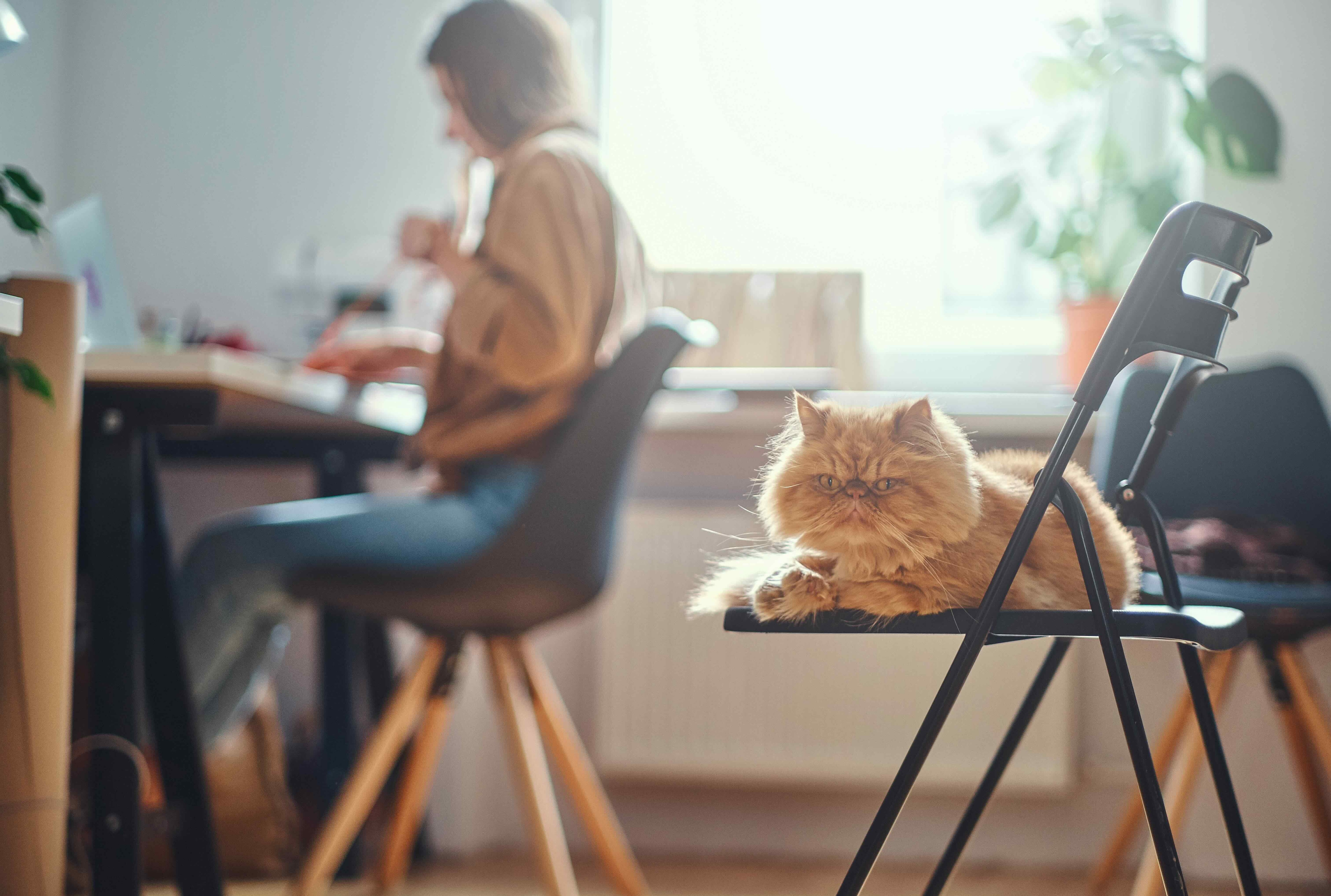 A regal red Persian cat lounging gracefully on a chair, with a woman working at a desk in the softly blurred background.
A regal red Persian cat lounging gracefully on a chair, with a woman working at a desk in the softly blurred background.
The Persian cat, instantly recognizable by its distinctive flat face and gloriously flowing coat, reigns as one of the most iconic long-haired breeds. Persians are renowned for their gentle and placid nature, thriving in serene and tranquil home environments. While deeply affectionate with their families, they may exhibit a reserved demeanor towards unfamiliar faces.
Persian cats boast a rich palette of coat colors, ranging from classic black, vibrant red, and delicate cream, to more unique and sought-after shades like blue and lilac, perfect for those seeking a gray long-haired feline companion. Maintaining the Persian’s signature fluffiness requires dedication to daily grooming. Regular brushing is essential to keep their luxurious coat and delicate facial area free from tangles and debris, effectively preventing matting and ensuring their comfort and well-being.
2. Himalayan
 A poised silver colorpoint Himalayan cat sits elegantly in lush green grass, gazing upwards with gentle curiosity.
A poised silver colorpoint Himalayan cat sits elegantly in lush green grass, gazing upwards with gentle curiosity.
The Himalayan cat, a delightful blend of Persian serenity and Siamese playfulness, emerges as an affectionate and charming long-haired breed. Created through the crossbreeding of Persians and Siamese cats, the Himalayan inherits the best of both worlds. Identifying a Himalayan is easy thanks to their characteristic “points” – areas of darker pigmentation that adorn their ears, mask, legs, feet, and tail.
These striking points create a beautiful contrast against the Himalayan’s creamy body coat. The point colors are diverse, including seal (a dark brown-black with warm undertones), blue, lilac, chocolate, and flame (a vibrant red-orange). Points can also manifest in solid colors or various patterns. The Himalayan’s coat texture can range from fine and silky to a denser, wooly feel, but regardless of texture, consistent daily brushing remains crucial to prevent matting and maintain its healthy sheen.
3. LaPerm
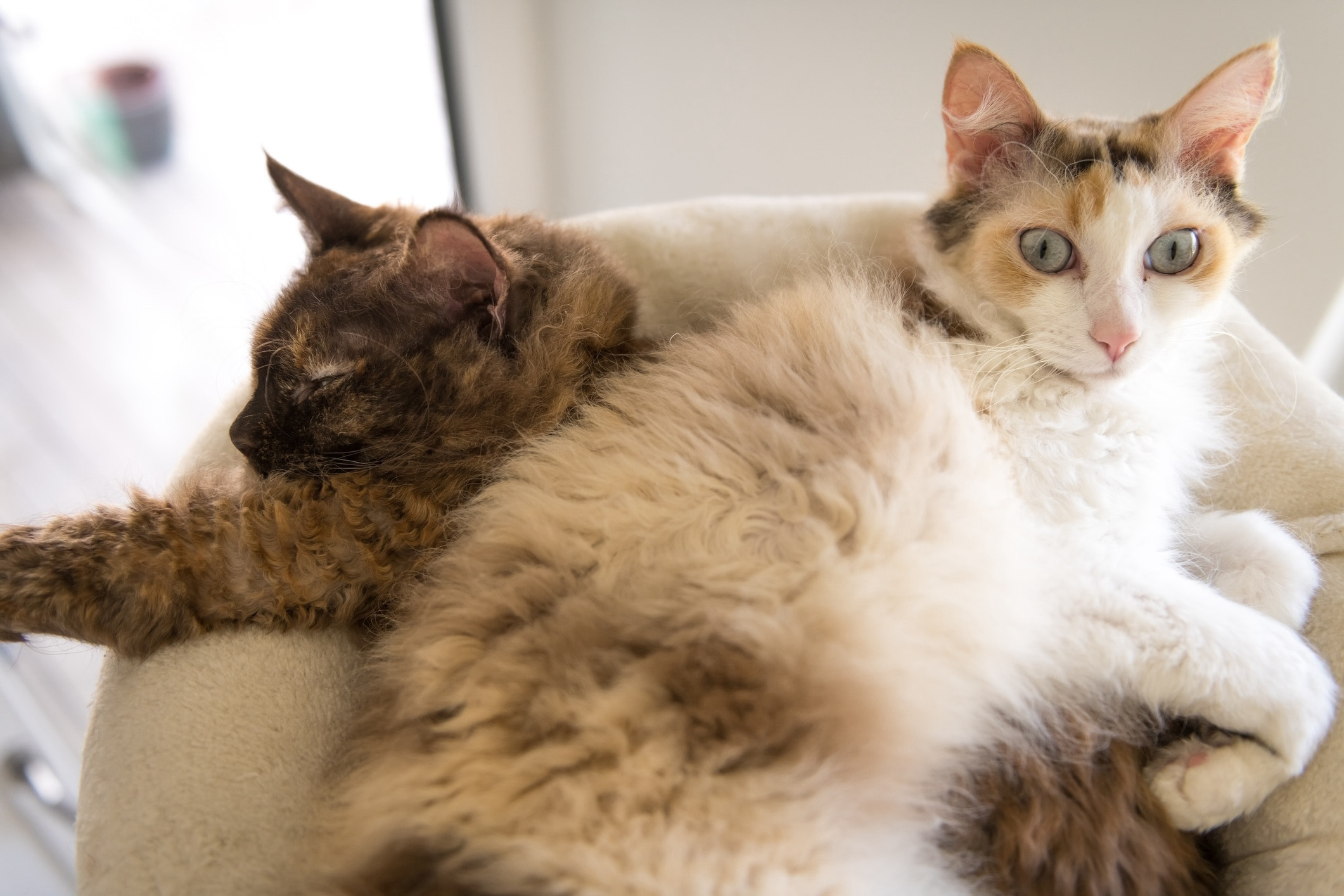 Two charming LaPerm cats with their distinctive curly coats, nestled together comfortably within a cat tree.
Two charming LaPerm cats with their distinctive curly coats, nestled together comfortably within a cat tree.
The LaPerm cat stands out as a truly unique long-haired breed, celebrated for its distinctive curly coat. This captivating feature arises from a natural genetic mutation, resulting in a coat that can be either long or short-haired, both exhibiting the signature curls or waves.
The long-haired LaPerm showcases a medium-long coat that can range from loose curls to gentle waves, boasting a springy and airy texture, as defined by the Cat Fanciers’ Association (CFA) breed standard. Despite their long fur, LaPerms are surprisingly low-shedding and are known for their affectionate and active personalities, making them wonderful companions for those seeking a less demanding long-haired cat in terms of grooming.
4. Maine Coon
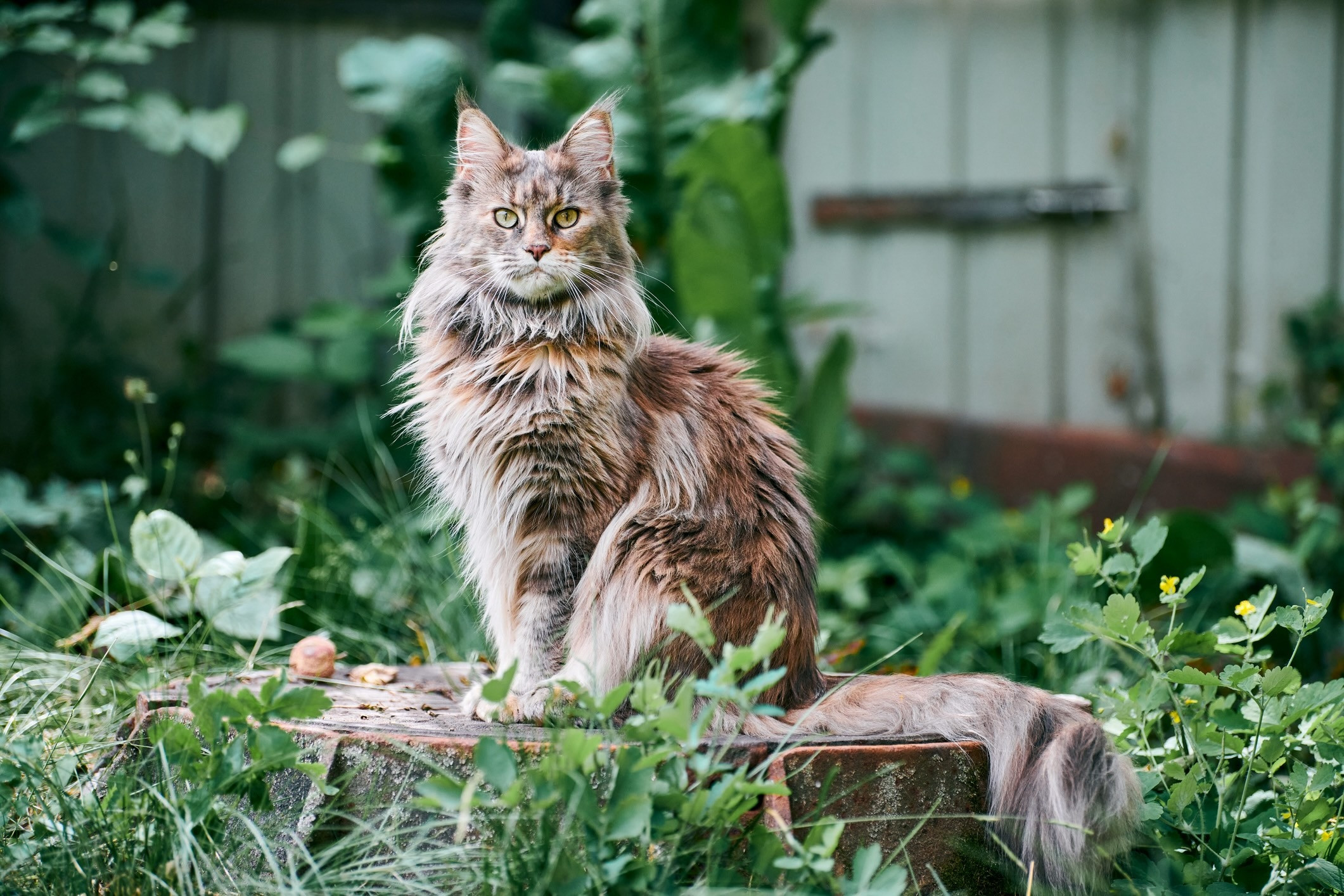 A magnificent brown and orange Maine Coon tabby sits regally in a vibrant garden, showcasing its impressive size and long coat.
A magnificent brown and orange Maine Coon tabby sits regally in a vibrant garden, showcasing its impressive size and long coat.
The Maine Coon, a gentle giant among long-haired cats, impresses with its large size, flowing coat, and exceptionally long whiskers, lending it a majestic appearance. Renowned for their friendly and intelligent nature, Maine Coons make exceptional family pets, often displaying almost dog-like traits in their loyalty and trainability.
As one of the largest domestic cat breeds, a fully grown Maine Coon can weigh up to 25 pounds or even more. Their thick, double coat provides excellent insulation but requires regular attention. Brushing at least a few times a week is necessary to keep their coat looking its best and to prevent tangles from forming in their dense fur.
5. Norwegian Forest Cat
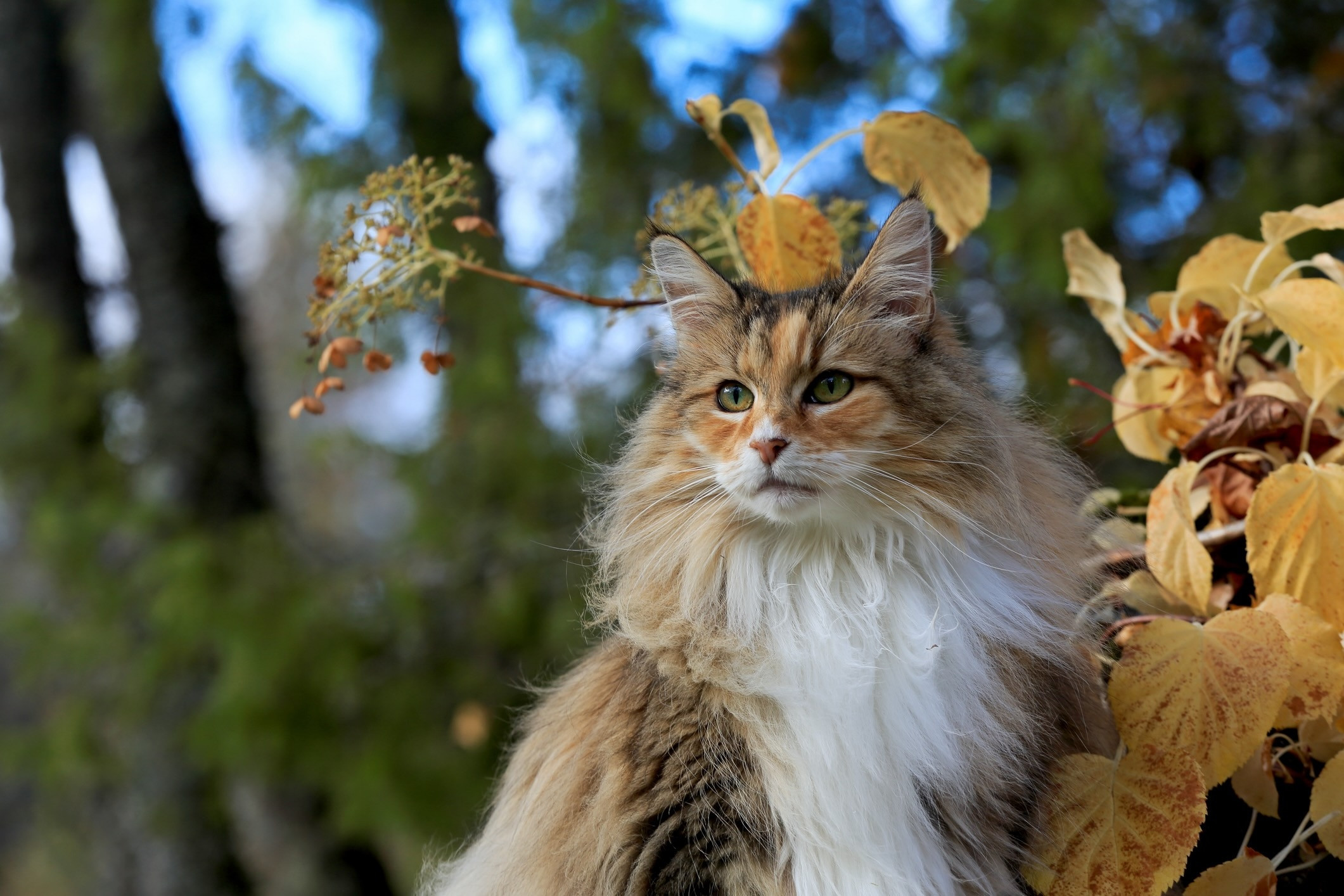 A striking Norwegian Forest Cat with a mix of white, brown, and orange fur, captured in a close-up outdoor shot, showcasing its robust build and thick coat.
A striking Norwegian Forest Cat with a mix of white, brown, and orange fur, captured in a close-up outdoor shot, showcasing its robust build and thick coat.
Another large and powerfully built long-haired breed is the Norwegian Forest Cat. Developed to withstand the harsh Scandinavian winters, these cats possess a remarkably thick double coat that provides excellent protection against cold and wet weather. To maintain their coat’s health and prevent matting, regular brushing several times a week is recommended.
Twice a year, Norwegian Forest Cats undergo a significant shedding period as they lose their winter coat. During these shedding seasons, increasing the frequency of brushing is essential to manage the loose fur and minimize shedding around the home. Their sociable and affectionate nature typically makes grooming sessions a pleasant experience, as they enjoy spending time and interacting with their human companions.
6. Ragdoll
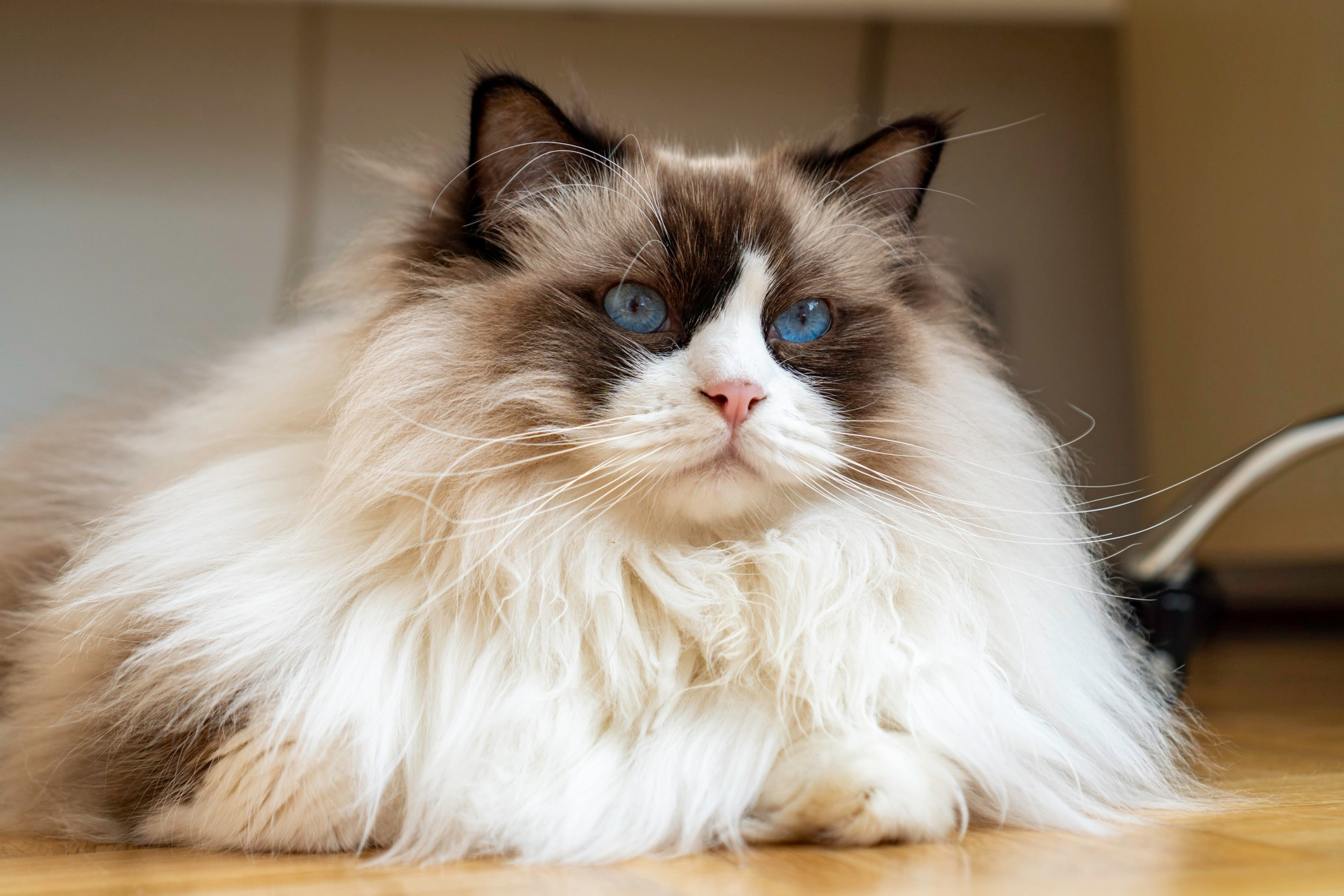 A serene close-up of a long-haired Ragdoll cat resting peacefully on the floor, highlighting its gentle expression and soft, flowing coat.
A serene close-up of a long-haired Ragdoll cat resting peacefully on the floor, highlighting its gentle expression and soft, flowing coat.
The Ragdoll cat breed is famed for its exceptionally docile and affectionate temperament, so much so that they often become completely limp and relaxed when held or petted, hence their name.
Ragdolls are considered one of the friendliest cat breeds and thrive in environments where they receive plenty of attention. They are best suited to homes with other pets or with humans who are frequently present. Beyond their need for companionship, Ragdolls are relatively easy to care for. Grooming once or twice a week is generally sufficient to keep their long, semi-long coat healthy and free of mats.
7. RagaMuffin
Closely related to the Ragdoll, the RagaMuffin cat is similarly known for its exceptionally affectionate and gentle disposition and deep bond with its human family. This long-haired breed possesses a luxuriously soft and silky coat, characterized by a distinctive ruff around the neck and slightly longer fur on their belly.
Despite its opulent appearance, the RagaMuffin’s coat is surprisingly low-maintenance. Weekly grooming with a comb is usually all that is needed to keep their fur in excellent condition and prevent tangles. This makes them a wonderful choice for those seeking a beautiful long-haired cat without demanding grooming needs.
8. Siberian
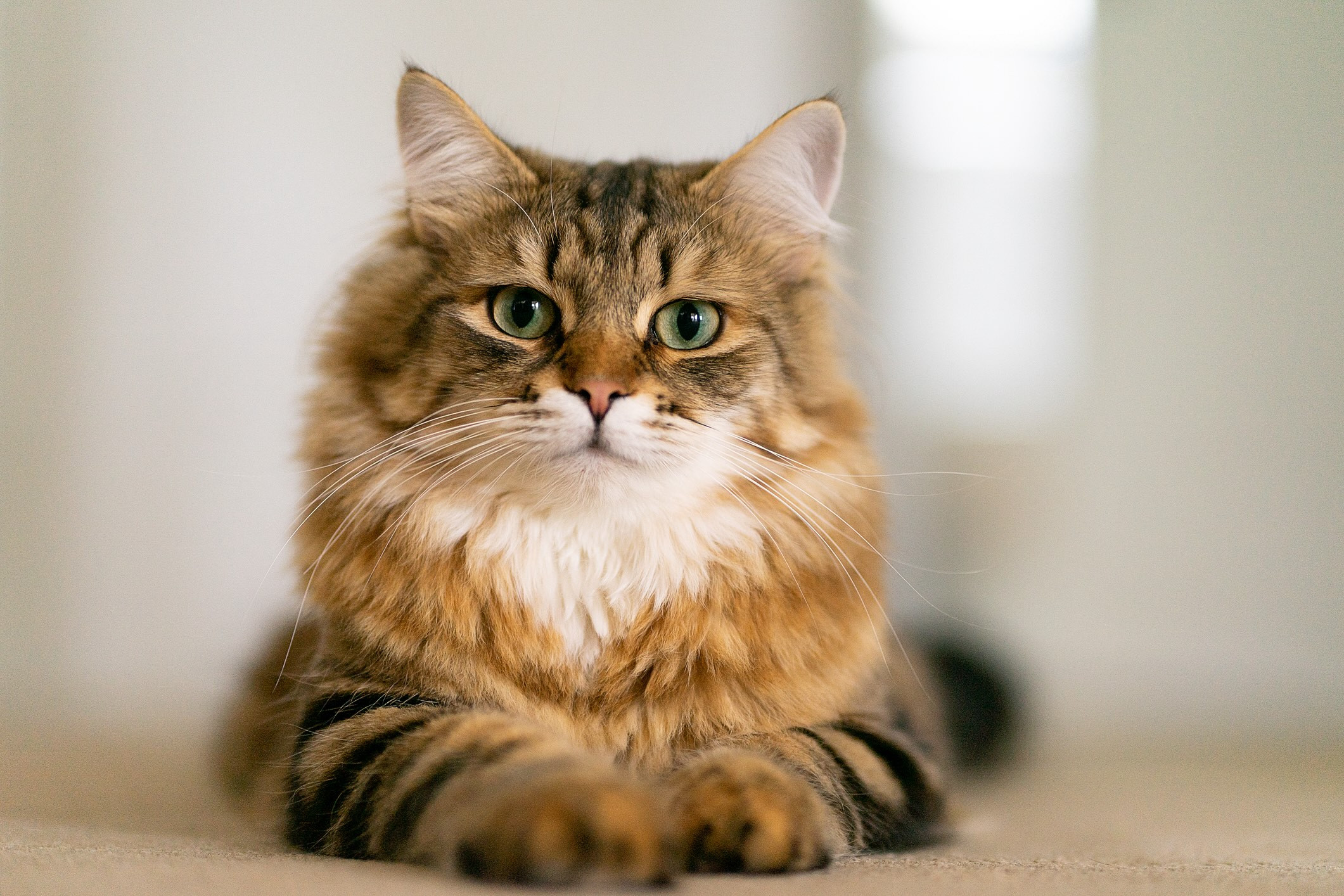 A handsome brown tabby Siberian cat lying down and looking directly at the camera, showcasing its alert expression and thick, protective coat.
A handsome brown tabby Siberian cat lying down and looking directly at the camera, showcasing its alert expression and thick, protective coat.
The Siberian cat distinguishes itself from other long-haired breeds with its unique triple coat, comprised of guard hair, awn hair, and a dense undercoat. While a triple coat might sound like a grooming challenge, Siberian cats are surprisingly low-maintenance. Weekly brushing is typically sufficient, except during shedding season.
During spring and fall shedding periods, more frequent brushing, even daily, becomes necessary to manage the molting undercoat and keep shedding under control. Siberians are also renowned for their friendly and outgoing personalities. They are known to be lap-loving companions, and are also intelligent, active, and trainable, making them engaging and interactive pets.
9. Selkirk Rex
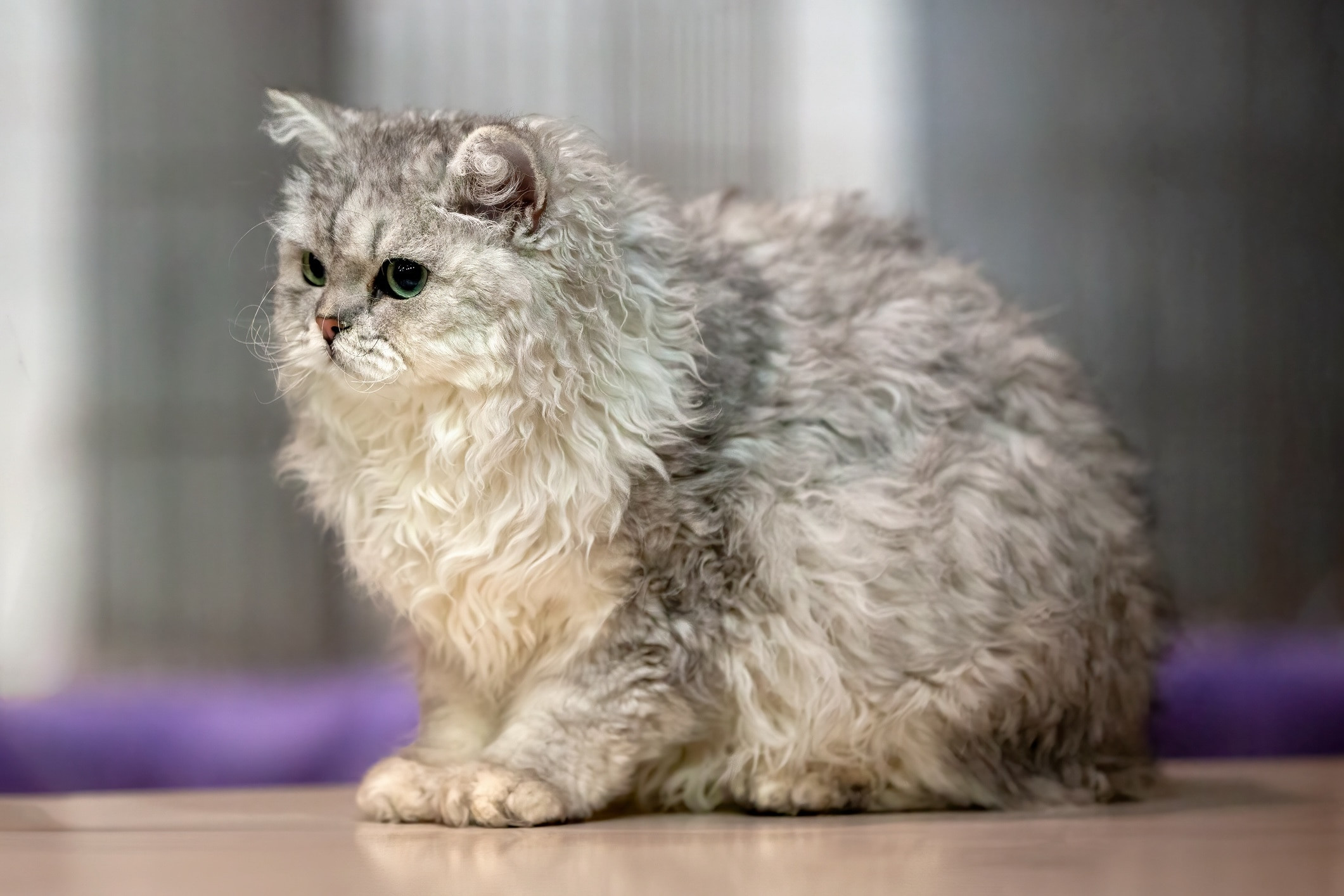 A charming Selkirk Rex cat with its signature curly coat, sitting attentively on the floor.
A charming Selkirk Rex cat with its signature curly coat, sitting attentively on the floor.
The Selkirk Rex is another curly-coated long-haired breed, inheriting its unique wavy fur from a naturally occurring gene mutation. The breed’s development also includes Persian lineage, contributing to its long and fluffy coat. However, unlike many long-haired breeds, the Selkirk Rex should not be brushed excessively, as over-brushing can disrupt their curl pattern and lead to frizziness.
Selkirk Rex cats are prone to developing oily skin and benefit from semi-regular bathing. Establishing a gentle brushing and bathing routine early in their life is recommended to ensure they become comfortable with the process.
10. American Bobtail
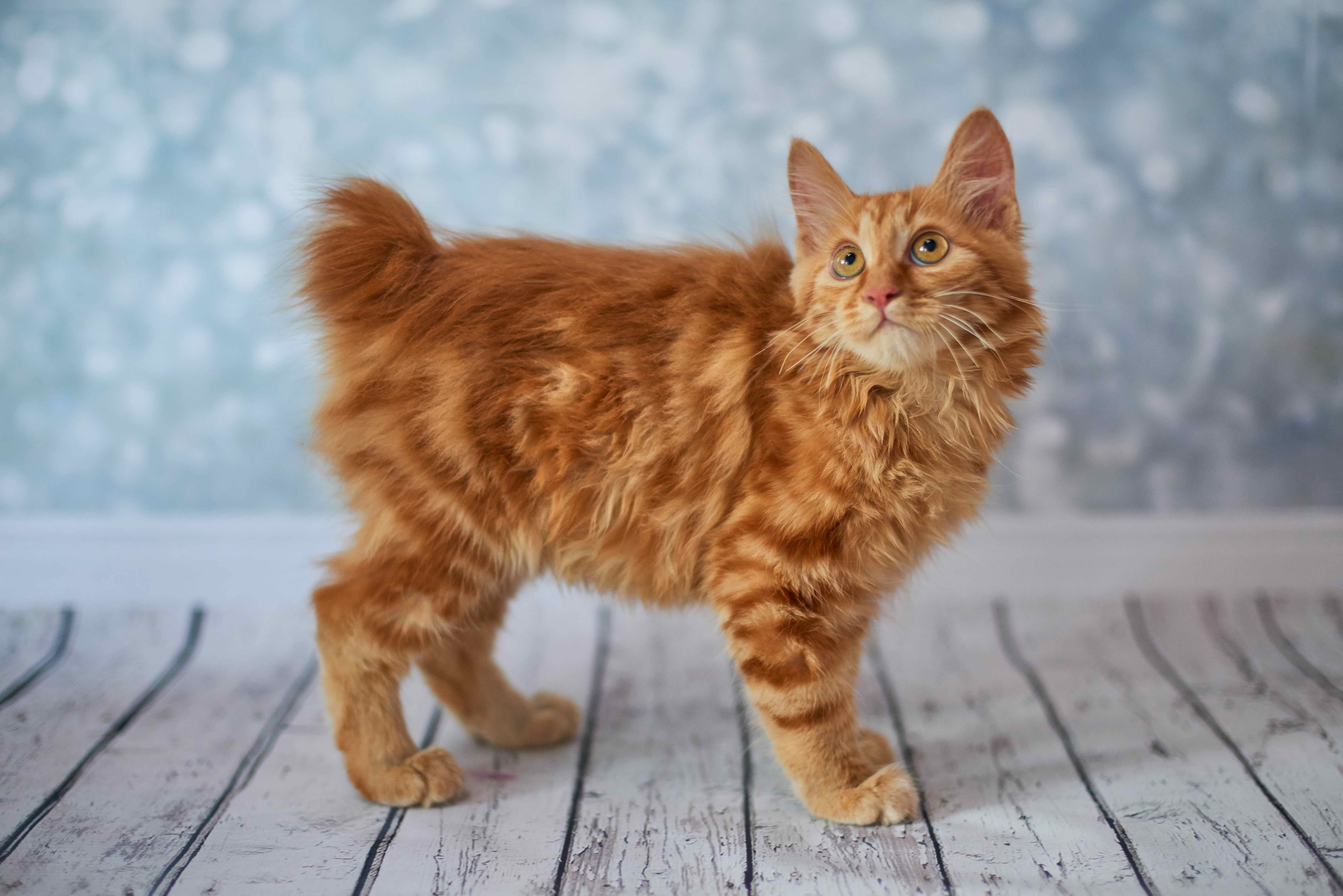 A fluffy and adorable red American Bobtail kitten, capturing its playful energy and distinctive short tail.
A fluffy and adorable red American Bobtail kitten, capturing its playful energy and distinctive short tail.
The American Bobtail cat is characterized by its shaggy, medium-long coat and, most notably, its short, bobbed tail, which can range in length but can be as short as just one inch. According to The International Cat Association (TICA) breed standard, American Bobtails can exhibit any coat color and pattern, offering a wide variety of appearances, from fluffy brown cats to long-haired orange cats.
This medium-sized breed is known for its adaptable and affectionate nature. American Bobtails are intelligent and playful, possessing the ability to learn tricks and enjoy interactive games, making them engaging companions for active households.
11. Birman
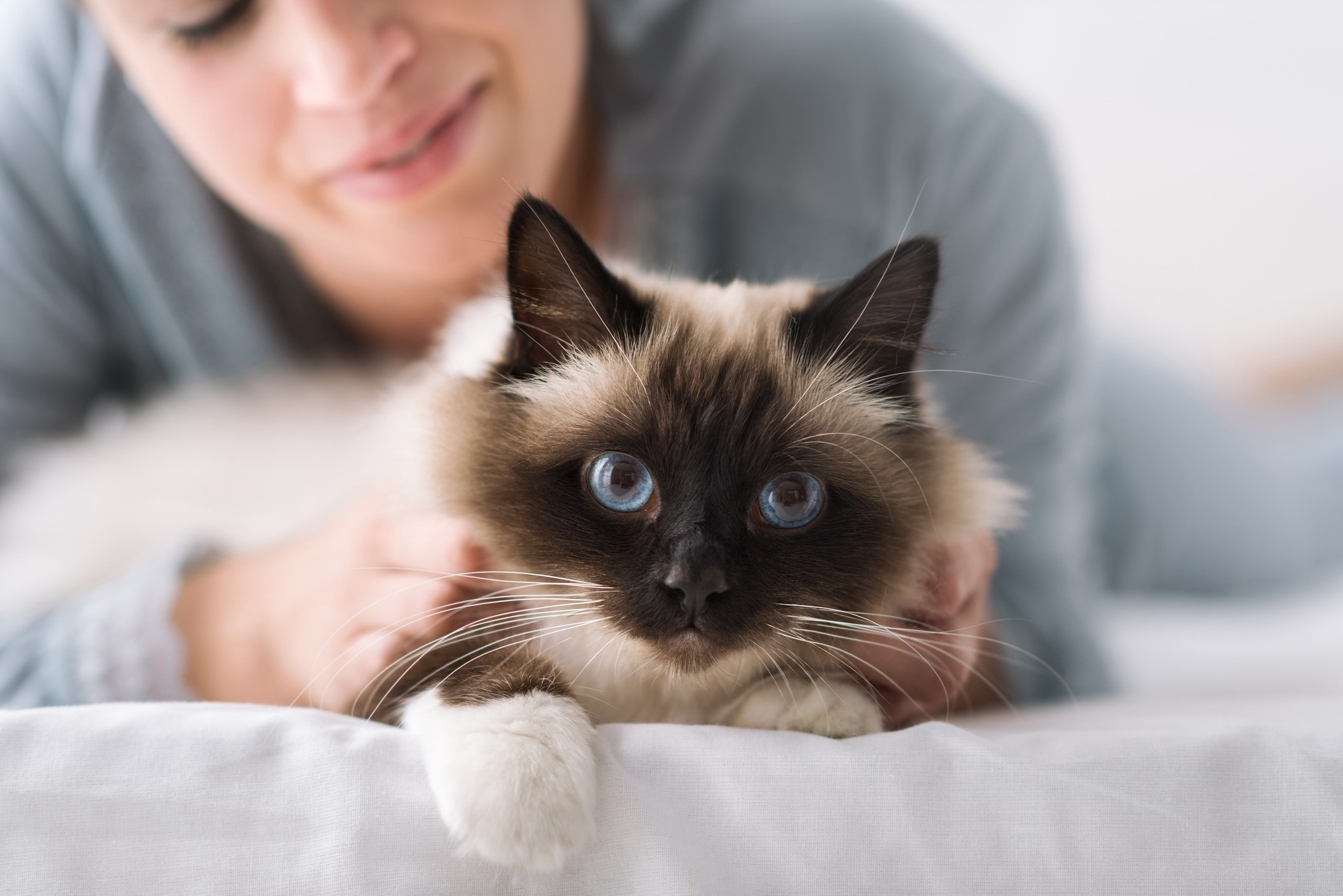 A heartwarming image of a woman gently petting a long-haired Birman cat on a bed, as the cat gazes directly into the camera with its striking blue eyes.
A heartwarming image of a woman gently petting a long-haired Birman cat on a bed, as the cat gazes directly into the camera with its striking blue eyes.
The Birman cat stands out with its captivating bright blue eyes and a beautiful coat that is typically white or cream, accented by distinct points of color on the face, tail, and legs, creating a striking and elegant appearance.
For those concerned about demanding grooming, the Birman offers good news. Their long, silky coat is less prone to tangling and matting compared to some other fluffy breeds. However, brushing a Birman a few times per week is still beneficial to minimize shedding and reduce the incidence of hairballs, contributing to their overall health and comfort.
12. Japanese Bobtail
The long-haired Japanese Bobtail is distinguished by its short, pom-pom-like tail, which should not exceed three inches in length. Their coat is medium-to-long, silky smooth, and lacks a prominent undercoat. This fine, smooth coat is easy to maintain with regular weekly brushing. Japanese Bobtails come in a wide array of colors, including solid shades, bi-color, and tri-color patterns, offering diverse aesthetic choices.
Japanese Bobtails are known for their highly interactive and people-oriented personalities. They are often vocal in seeking attention and are known to boldly and readily befriend new people, making them social and engaging companions.
13. Pixiebob
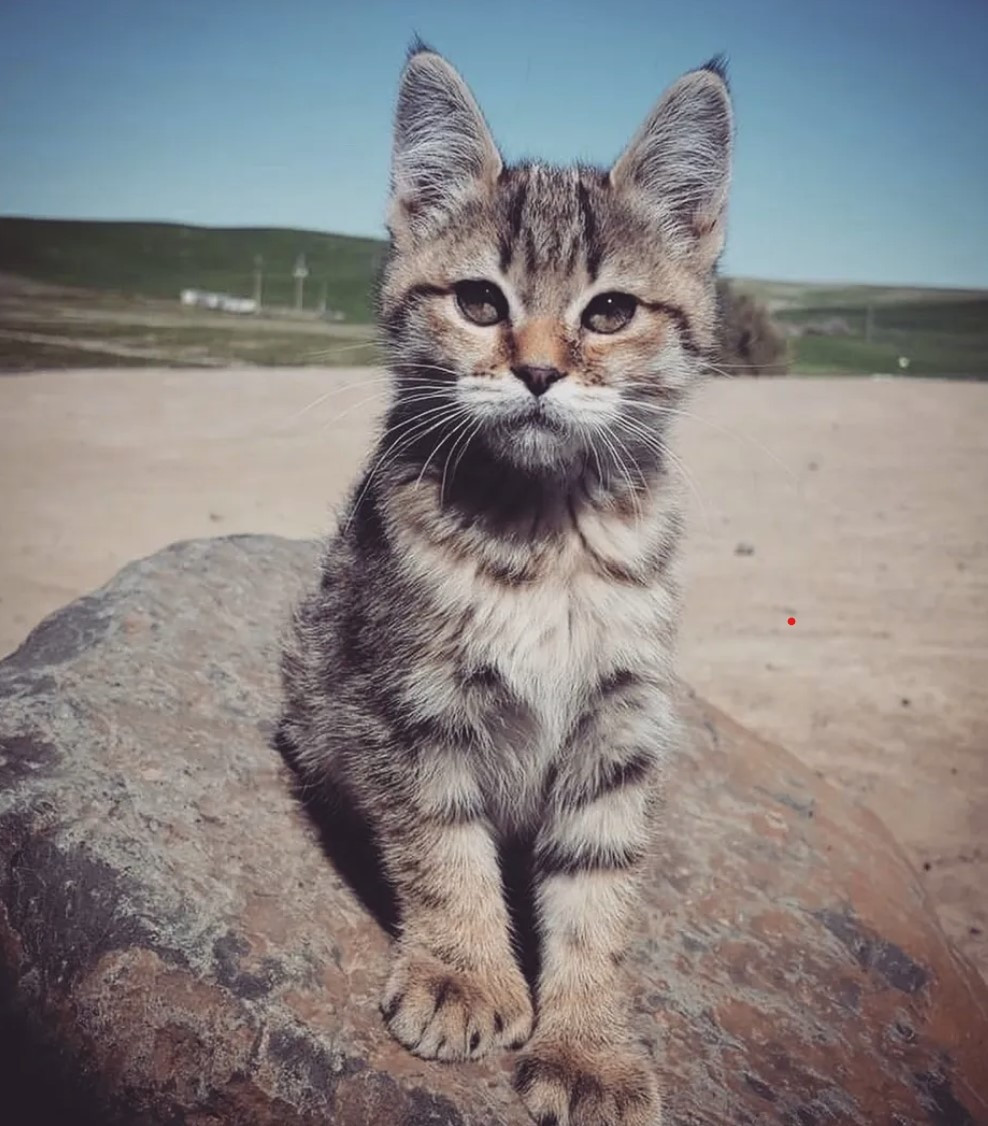 A charming Pixiebob kitten with distinctive extra toes, sitting and looking inquisitively at the camera.
A charming Pixiebob kitten with distinctive extra toes, sitting and looking inquisitively at the camera.
The Pixiebob breed is selectively bred to resemble the wild North American bobcat, capturing a slightly wild look in a domestic cat. The breed standard recognizes both shorthaired and long-haired varieties, both characterized by full and bushy facial hair that contributes to their bobcat-like appearance.
Long-haired Pixiebobs have a soft coat that is approximately two inches in length and lies close to the body. Despite their somewhat wild appearance, Pixiebobs possess a relaxed and friendly temperament, making them excellent house pets. Their gentle nature and adaptable personalities make them suitable for a variety of home environments.
14. Turkish Angora
 A sleek black Turkish Angora cat lying gracefully against a black backdrop, emphasizing its elegant lines and silky coat.
A sleek black Turkish Angora cat lying gracefully against a black backdrop, emphasizing its elegant lines and silky coat.
The Turkish Angora boasts a smooth, silky coat that is both beautiful and remarkably low-maintenance. Lacking an undercoat, they are less prone to matting compared to many other long-haired breeds. However, brushing a Turkish Angora a few times each week is still recommended to keep their coat healthy and free of loose hair.
In contrast to some cuddlier long-haired breeds, the Turkish Angora is not typically known for being overly affectionate in a lap-cat sense. However, they are playful and enjoy active play sessions with people and other pets. They are also known to be quite vocal, adding to their interactive and engaging personalities.
15. Turkish Van
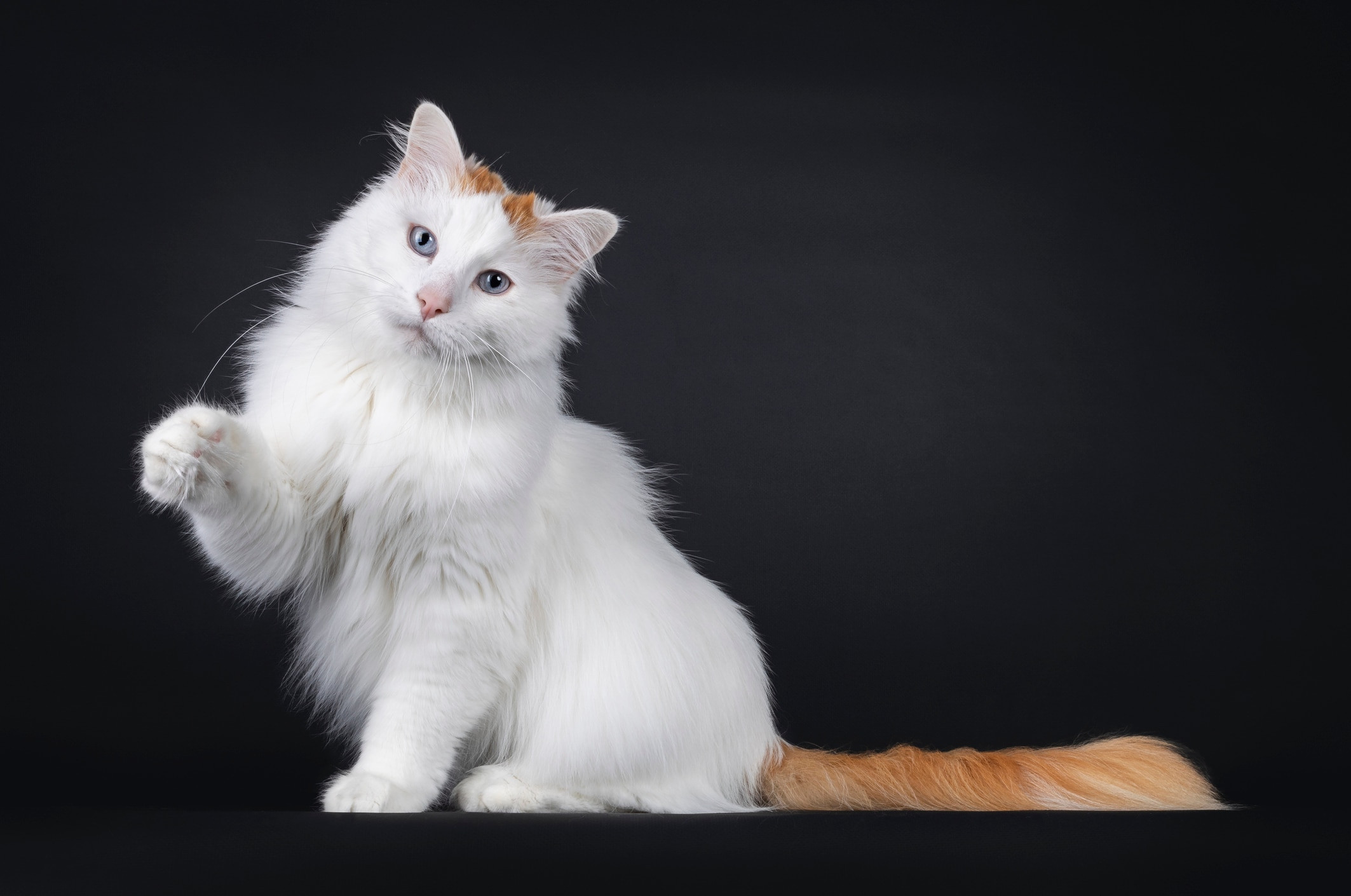 A striking white and orange Turkish Van cat against a black background, highlighting its distinctive color pattern and robust build.
A striking white and orange Turkish Van cat against a black background, highlighting its distinctive color pattern and robust build.
Another relatively low-maintenance long-haired breed is the Turkish Van. Interestingly, Turkish Vans are born with a shorter coat that gradually develops into its full long-haired glory as they mature, typically reaching their full coat by the age of 3 to 5 years.
Even in adulthood, the Turkish Van’s coat exhibits seasonal changes, becoming shorter in the warmer summer months and growing thicker and longer during the winter. Regardless of the season, the Turkish Van is characterized by a full, bushy tail and prominent ear tufts, adding to their distinctive appearance.
Caring for Your Long-Haired Feline Friend
The fundamental care requirements for long-haired cats are largely consistent with those of any cat breed. They thrive on proper nutrition, require ample mental stimulation, and need essential resources such as a clean litter box and stimulating cat toys. However, long-haired breeds often necessitate a more significant commitment to grooming to maintain their beautiful coats and overall well-being.
Regular brushing and routine nail clipping are the cornerstones of long-haired cat care. Investing in a quality comb and brush specifically designed for long fur is essential for effectively removing loose fur, minimizing dander, and keeping their coats smooth and tangle-free.
Mastering the correct techniques for brushing your cat and ensuring a positive grooming experience are crucial. Make grooming enjoyable by offering plenty of affection and treats throughout the session. However, avoid over-brushing, as excessive brushing can sometimes lead to hair breakage and a frizzy coat texture.
For stubborn mats that are difficult to remove at home, seeking the expertise of a professional groomer is advisable. In fact, regular visits to a professional groomer can be particularly beneficial for certain long-haired breeds, especially those with very dense or profuse coats like Persians or Siberians. A groomer can provide thorough brushing, expert mat removal, and even offer trims to simplify at-home grooming routines, ensuring your long-haired cat always looks and feels its best.
WRITTEN BY
Erica Puisis
Freelance Writer

